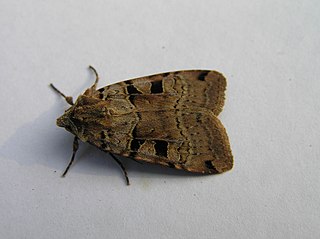
The double square-spot is a moth of the family Noctuidae. It is distributed through most of Europe except Portugal, the Mediterranean islands and northernmost Fennoscandia. In the East, the species ranges East across the Palearctic to Siberia and in the South-East to the Black Sea and in Iran. It rises to a height of about 2000 metres in the Alps.

Apamea crenata, known as the clouded-bordered brindle, is a moth in the family Noctuidae. It is distributed throughout the Palearctic realm. In the North it crosses the Arctic Circle, in the Mediterranean it is found only in cool locations and mountains avoiding very hot areas. In the Alps, it rises to an altitude of about 2000 metres.

Miletus symethus, the great brownie, is a small butterfly found in India that belongs to the lycaenids or blues family. The species was first described by Pieter Cramer in 1777.

Curetis bulis, the bright sunbeam, is a species of butterfly belonging to the lycaenid family. It is found in Asia.
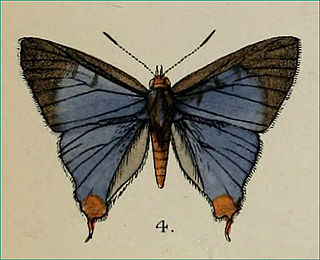
Cigaritis abnormis, the abnormal silverline, is a species of lycaenid or blue butterfly found in south India and Pakistan.
Enchrysa is a genus of moths in the family Gelechiidae. It contains the species Enchrysa dissectella, which is found in North America, where it has been recorded from Maine, Minnesota, New Hampshire, Ohio and Ontario.

Mythimna albipuncta, the white-point, is a moth of the family Noctuidae. The species was first described by Michael Denis and Ignaz Schiffermüller in 1775. It is distributed throughout Europe and one subspecies is found in Tunisia. It is also found in Asia Minor, Armenia, and Iran, and the northeastern United States.
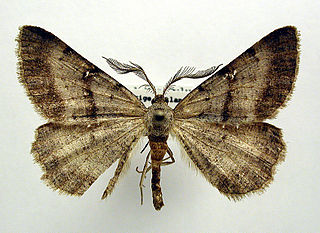
Selidosema brunnearia, the bordered grey, is a moth of the family Geometridae. The species was first described by Charles Joseph Devillers in 1789. It is found in central and southern Europe, Asia Minor, Transcaucasia and North Africa.

Epinotia tetraquetrana, the square-barred bell, is a moth of the family Tortricidae. It is found from most of Europe east to the Near East and the eastern part of the Palearctic realm.

Charaxes andara is a butterfly in the family Nymphalidae. It is found in eastern and southern Madagascar, where it is found in forests. It is very similar to Charaxes brutus, of which it has been considered a subspecies.

Cochylichroa atricapitana, the black-headed conch, is a moth of the family Tortricidae. It is found in China (Xinjiang) and the eastern Palearctic and most of Europe.

Sparganocosma is a genus of moths in the family Tortricidae. It contains only one species, Sparganocosma docsturnerorum, which is found in north-western Costa Rica.

Cnephasia longana, the omnivorous leaftier moth, long-winged shade or strawberry fruitworm, is a moth of the family Tortricidae. It was described by Adrian Hardy Haworth in 1811. It is native to western Europe. It is an introduced species in western North America. The species has also been reported from north-western Africa and Asia. The habitat consists of downland and rough ground.
Archips eupatris is a species of moth of the family Tortricidae first described by Edward Meyrick in 1908. It is found in Sri Lanka.
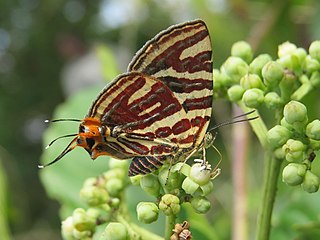
Cigaritis lohita, the long-banded silverline, is a species of lycaenid or blue butterfly.
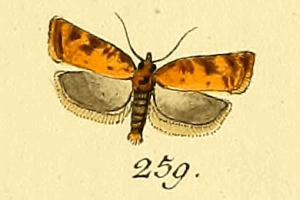
Acleris aspersana, the ginger button, is a species of moth of the family Tortricidae. It is found in Europe, where it has been recorded from Ireland, Great Britain, France, the Benelux, Germany, Denmark, Austria, Switzerland, Italy, the Czech Republic, Slovakia, Slovenia, Croatia, Hungary, Bulgaria, Romania, Poland, Norway, Sweden, Finland, the Baltic region and Russia. It is also found in the Near East and the eastern Palearctic realm. Their habitat consists of meadows and forest edges.

Acleris bowmanana is a species of moth of the family Tortricidae. It is found in North America, where it has been recorded from Alberta, British Columbia, California, Maine, Manitoba, Maryland, Michigan, New Brunswick, Ontario, Quebec, West Virginia and Wisconsin.
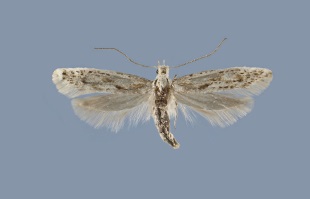
Kessleria cottiensis is a moth of the family Yponomeutidae. The species was first described by Peter Huemer and Marko Mutanen in 2015. It is found only in a small area in the south-western Alps of Italy and France. The habitat consists of alpine grasslands interspersed with calcareous rocks.

Kessleria dimorpha is a moth species of the family Yponomeutidae. It is found only on the French side of Col Agnel, close to the Italian border. The habitat consists of rocky areas on siliceous soil
Diplosemaphora amphibola is a moth of the family Tortricidae first described by Alexey Diakonoff in 1982. It is found in Sri Lanka.
















